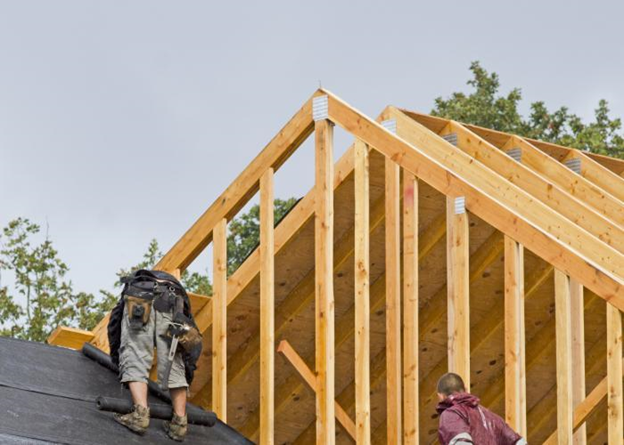With rising energy costs, many people are looking to save money. Along with opting for energy-saving light bulbs, fixing leaky ductwork, and purchasing energy-efficient appliances, you can also opt for energy-efficient roofing.
Did you know that energy-efficient roofing can save you hundreds of dollars a year? It does this by reflecting the sun’s rays and releasing the heat instead of absorbing it into your home’s interior. This helps reduce energy use resulting in lower utility bills. It also can increase the longevity of your roof and save you money on costly repairs.
On this page, we will tell you what energy-efficient roofing is and 7 types of roofs to help you devise what is the best option for you when it comes to roof repairs Warwick.
What is Energy-efficient Roofing?
Energy-efficient roofing is made of material that reflects the sun’s easily and emits it back into the atmosphere, decreasing the amount of heat absorbed by the roof and seeping into your home. This can lower the roof’s surface heat by as much as 50 degrees, meaning that your air conditioner won’t have to work as hard, saving you money on utility bills.
7 Best Energy-Efficient Roofing Options
1. Metal Roofing
Metal roofs can last as long as 50 years when properly installed. The interlocking panels provide resistance to wind and other extreme weather. Plus, the roofs are lightweight, so they reduce the stress on the building supports, fireproof, meaning that they resist the energy of fire ember and radiation. In addition, they also reflect heat, which can reduce your use by 25 percent.
Many people don’t realize that metal roofing comes in a wide variety of shapes, substrates, wide variety of colors and styles. Currently, they have the best heat reflection ratios in the industry. While metal is pretty expensive and requires professional installation, it’s still one of the best choices for an energy-efficient roof.
2. Clay Roofing Tiles
The raw materials that roofing tiles are made up of have natural heat resistance. Roofing tiles can lower your heating and cooling costs by as much as 20 percent. These tiles overlap with each other, which allows circulation. The air channels provide an extra layer of insulation and a way for hot air to circulate out before it goes into the building. Like metal roofing, these tiles are highly resistant to fire and damage as a result of extreme weather.
These tiles are made by baking molded clay. The density of the tiles is determined by how long the tiles are heated. The colors that come in are various shades of white, yellow, orange, and ever brown; however, the most common color is Terra-cotta. Because of how these tiles are made, it makes it where they don’t peel or fade.
3. Concrete Tiles
These tiles are made similar to how concrete is made, which is a mixture of sand, cement, and water. Like other tiles, they are molded under heat and high pressure. These tiles are heavier than other tile roofs and put more structural demand on your home. They are also water and weather-resistant. Concrete tiles have a Class A fire rating, meaning they are resistant to fire with a life expectancy of 50+ years.
4. Solar Tile Roofing
This tile is great because not only does it reflect heat, it also generates energy itself. Like solar panels, they come equipped to convert sunlight into electricity. They are beautiful and provide an elegant profile like other types of roofing material. This roofing material is more expensive than different types of tiles. Within a decade, they should pay for themselves through energy savings and solar incentives.
5. Asphalt Shingle Roofing
The reflective granules in asphalt shingles have an SRI rating and qualify for energy efficiency standards and cost less than many other types of roofing. However, you need to know that most shingles don’t have the costed granule, so you’ll want to talk to your roofer about the type you want.
6. Wood Shingles
These shingles are machine sawn, while wood shakes are hand-split pieces of wood overlapped when installed. Wood shingles are most often manufactured by western red cedar, Cyprus, pine, and redwood trees. This shingle is a natural insulator, resistant to winds & pests, highly durable, and beautiful.
7. Polymer Shingles
These shingles are also known as synthetic or composite shingles and are shaped to resemble other shingles or tiles. They are overlapped to cover the entire roof. Polymer shingles are made from 100 percent recycled materials, which are environmentally friendly. The biggest downside to one made of 100% recycled materials is that they have a lifespan of 35 years, while the virgin polymers designed for roofing last over 50 years.
Other Energy-efficient Roofing Options
- Insulation is a way to decrease your energy costs up to 10 percent without having to touch your roof. It works by stopping the outside temperature from penetrating your attic space. It also prevents cool air and heat from escaping your home, reducing the need to keep your heater and air conditioners cranked.
- Cool roof coating is another option, especially if you live in a hot climate. This white, reflective coating maximizes the roof’s ability to reflect and emit heat. If you have a sloped roof, these will decrease curb appeal, which is why these are recommended for low-sloped roofs.
- Improving ventilation allows air to flow through the attic space and escape through the roof vents. It also prevents condensation from developing, which can lead to damage and health risks.
- Selecting a lighter color for your roof significantly impacts the amount of heat that enters your home. Lighter colors such as light grey, light tan, and white are great choices to reflect heat and keep your home cooler in the summer.
Is There Anything Else I Should Consider?
While energy efficiency is important, you’ll also want to choose a roofing material that fits other criteria: cost, quality, and durability. When selecting the color of your roof, you also want to think about which best matches your home’s style and personal preferences.
While thinking about these things, it’s a good idea to talk to a professional regarding your options and priorities. A local roofing professional helps to evaluate and speak with you about creating a roof that’s both energy-efficient and functional.
















